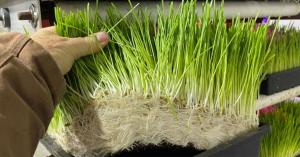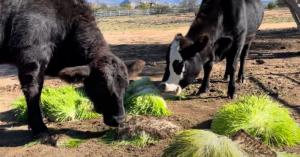Revolution on the Range: How Sprouting Gear Slashes Carbon Output in Feedyards
Sprouting Gear slashes cattle feed emissions by 95% with on-site hydroponic fodder—cutting costs, land use, and boosting herd health and growth.
We’re replacing a carbon-heavy, land-intensive system with a clean, efficient, localized one, that’s not just good for the planet—it’s good for the bottom line.”
RAMONA, CA, UNITED STATES, July 1, 2025 /EINPresswire.com/ -- As agriculture comes under increasing scrutiny for its role in climate change, Sprouting Gear Inc. is giving the livestock industry a powerful new tool: a feed system that slashes carbon emissions by more than 95% while improving cattle performance and lowering costs.— Paul Pluss, Founder and CEO of Sprouting Gear Inc.
“Our hydroponic barley fodder system isn’t just about growing feed—it’s about growing smarter,” said Paul Pluss, founder and CEO of Sprouting Gear. “By eliminating tractors, fuel, transport, and massive irrigation infrastructure, we’re cutting the carbon footprint of feedyards to a fraction of what it is today.”
Carbon Emissions: A Hidden Cost of Cattle
The traditional cattle feeding model relies heavily on fossil fuels and heavy machinery—from planting and harvesting to transporting across long distances. This creates one of the highest per-acre emissions profiles in U.S. agriculture.
Sprouting Gear’s 3-stage vertical farming system flips the model:
- No diesel-powered tractors
- No field irrigation
- No long-haul feed transport
- No tilling, spraying, or fertilizing
- Minimal packaging, waste, and spoilage
Instead, it produces fresh, living feed on-site, using a fully enclosed, automated hydroponic process. This approach reduces the carbon emissions per ton of feed by up to 95%.
“We’re replacing a carbon-heavy, land-intensive system with a clean, efficient, localized one,” said Pluss. “That’s not just good for the planet—it’s good for the bottom line.”
A Triple Win: Cost, Carbon, and Cattle Health
Alongside emissions reductions, the system improves efficiency in three key ways:
- Lower Fuel & Labor Costs – No heavy machinery or field operations.
- Reduced Land Pressure – 93% less land required for the same feed output.
- Better Cattle Outcomes – Barley fodder improves digestion and nutrient absorption, often resulting in faster weight gain and lower water intake.
Sprouting Gear’s solution also aligns with emerging opportunities in carbon credits, sustainability grants, and ESG-focused financing, making it a smart investment for forward-thinking ranchers.
An Industry in Transition
With global pressure mounting to reduce agricultural emissions—and beef production in particular—Sprouting Gear is proving that innovation doesn’t mean compromise. It means transformation.
“We don’t believe sustainability is a burden,” Pluss said. “We believe it’s a competitive advantage.”
Sprouting Gear’s hydroponic fodder systems are available through its licensing program, allowing producers to build scalable, carbon-reducing feed production facilities customized to their herd size and operational goals.
About Sprouting Gear Inc.
Sprouting Gear is redefining how cattle are fed in the 21st century. With its proprietary hydroponic barley fodder technology, the company empowers feedyards to cut emissions, save water, lower costs, and produce healthier livestock feed with year-round reliability.
To learn more or request a carbon impact analysis, visit: 👉 www.sproutinggear.com
Paul Pluss
Sprouting Gear
info@sproutinggear.com
Visit us on social media:
YouTube
LinkedIn
Instagram
Facebook
Can We REALLY Slash Livestock Environmental Damage By 90 Percent?
Legal Disclaimer:
EIN Presswire provides this news content "as is" without warranty of any kind. We do not accept any responsibility or liability for the accuracy, content, images, videos, licenses, completeness, legality, or reliability of the information contained in this article. If you have any complaints or copyright issues related to this article, kindly contact the author above.


